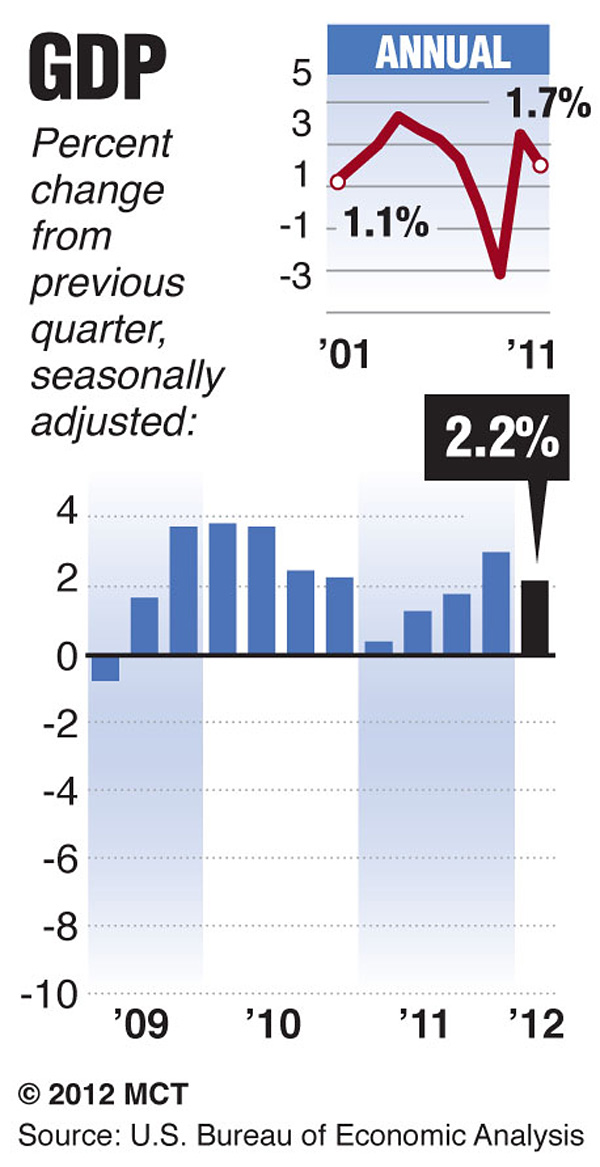 By Don Lee, Tribune Washington Bureau –
By Don Lee, Tribune Washington Bureau –
WASHINGTON — The American economy grew at a sluggish rate in the first quarter, stirring more doubts about the strength of the recovery and the outlook for jobs in coming months.
(GRAPHIC: Monthly economic indicator: Trend in U.S. GDP (gross domestic product).)
The economy expanded at a lackluster 2.2 percent annual rate in the first three months of the year, down from a 3 percent pace in the fourth quarter of last year, the Commerce Department said Friday.
Most analysts were expecting the gross domestic product — the total value of goods and services produced in the U.S. — to increase at a 2.6 percent rate or more in the January-March period.
The disappointing GDP number mostly reflected a slowdown in business investments and a smaller buildup of inventories. But it also was caused by a rise in imports and a sizable and unexpected cutback in defense spending.
Beneath the surface, there were some encouraging signs. Consumer spending was solid. More people, shrugging off higher oil prices and economic tremors from Europe, bought cars as well as other goods and services.
Defense spending is likely to provide a stronger economic boost in the months ahead, given congressional budget estimates, said Ben Herzon, senior economist at Macroeconomic Advisers, a forecasting firm in St. Louis.
And rising imports aren’t all bad either, because they sometimes indicate growing demand for products, including those made domestically.
“Separating the wheat from the chaff, the basic story is that economic growth is continuing, though at a sluggish pace,” said Sung Won Sohn, an economist with the Smith School of Business at California State Channel Islands.
“We aren’t in danger of falling off the cliff,” he said. “We will continue to see moderate growth.”
Whether growth slows or accelerates over the coming quarters will depend largely on consumer spending, which accounts for about two-thirds of U.S. economic activity.
Personal consumption grew at an annual rate of 2.9 percent in the first quarter, up from 2.1 percent in the final three months of last year. But to support the greater spending, consumers took on more debt.
Friday’s report showed that the personal saving rate fell from 4.5 percent in the fourth quarter to 3.9 percent in the first quarter, the lowest since the recovery began in mid-2009.
Adding to the uncertain outlook, experts weren’t sure how much the warm winter weather may have bolstered consumer spending and housing construction, which boosted GDP modestly in the first quarter.
Consumer sentiment measures have edged higher in recent months, and demand for homes is improving amid a tighter supply. But both of these key drivers are highly dependent on job and income growth — and the latest signs are mixed on whether businesses will step up hiring in coming months.
Many economists, including those at the Federal Reserve, are projecting GDP growth of about 2.5 percent this year. That’s better than last year’s 1.7 percent rate, but still a middling pace that’s unlikely to translate into strong job growth and satisfactory progress in lowering the national unemployment rate, currently at 8.2 percent.
Still, it isn’t likely that the latest GDP report will prompt the Fed to take further steps to stimulate the economy.
Stock markets rose moderately Friday as strong corporate earnings reports and a steady consumer confidence reading from the University of Michigan offset the weak GDP data.
The big question for the economy is whether businesses will pick up their pace of hiring.
Many of the country’s largest employers are continuing to do very well. Wal-Mart Stores Inc. had more sales, profit and stores in its last fiscal year than ever before. United Parcel Service Inc. last year recovered all of the business of shipping domestic packages lost in the recession.
And for the first time in more than half a century, General Electric Co. opened a factory in its appliance manufacturing complex in Louisville, Ky., bringing back some production from China and Mexico.
Yet for all these notable achievements, total domestic employment didn’t budge at any of these three corporations. And recent government data showed that multinational companies overall persisted in hiring more aggressively overseas than in the U.S., where companies are finding ways to employ new technologies but not more people.









